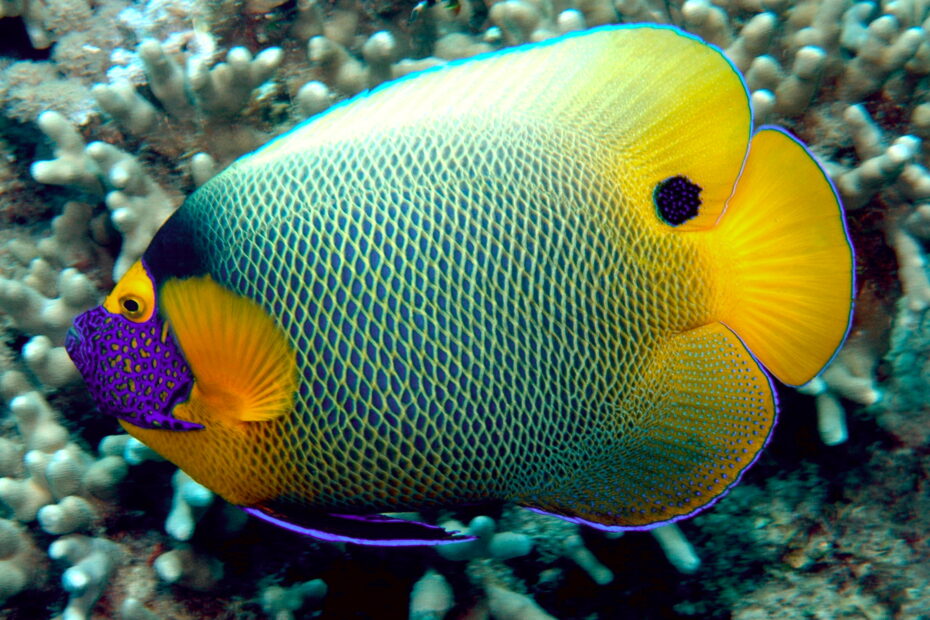The Blueface Angelfish (Pomacanthus xanthometopon), also known as the Yellowface Angelfish, is a striking marine species celebrated for its vibrant coloration and distinctive facial markings. Native to the Indo-Pacific region, it is a popular choice among marine aquarists.
Key Information
• Small fish safe: Yes
• Small invert safe: ⚠️ With caution
• Coral safe: ⚠️ With caution
• Minimum tank size: 830 liters (220 gallons)
• Adult size: Up to 38 cm (15 inches)
• Diet: Omnivorous, with a preference for sponges and tunicates; may also accept mysis shrimp, brine shrimp, and specialized angelfish preparations containing sponges.
• Be aware of: May nip at corals and small invertebrates; requires a large, well-established tank with ample hiding spots and live rock for grazing; can be territorial, especially towards similar species.
Appearance and Coloration
The Blueface Angelfish is renowned for its distinctive and vibrant appearance:
• Body: A reticulated pattern of pale blue scales edged with yellow, creating a net-like effect.
• Face: Bright yellow mask around the eyes, with a dense network of brilliant blue lines covering the lower half of the face.
• Fins: Large and rounded, predominantly yellow, with some edged in blue. The dorsal fin features a distinctive black eyespot at the base.
Juveniles exhibit markedly different coloration, with six vertical white bars separated by pale blue lines and a caudal fin barred in two shades of blue. They undergo a gradual color transformation as they mature, typically starting at a length of 7 to 12 cm.
Natural Habitat and Behavior
In the wild, Blueface Angelfish inhabit coral-rich areas of lagoons, outer reef slopes, and channels at depths up to 25 meters. They are often found near rocks and caves, with juveniles frequently residing inside caves. These fish are typically solitary or found in pairs and feed on tunicates, sponges, other encrusting organisms, and algae.
Tank Requirements and Water Parameters
To ensure the well-being of Blueface Angelfish in captivity:
• Minimum Tank Size: A 220-gallon (830 liters) aquarium is recommended to provide ample space for swimming and territory establishment.
• Water Parameters:
• Temperature: 72°F – 78°F (22°C – 25.5°C)
• pH: 8.1 – 8.4
• Specific Gravity: 1.020 – 1.025
• Aquascaping: Incorporate plenty of live rock to create hiding spots and grazing areas, mimicking their natural reef environment.
• Lighting: Moderate lighting is suitable.
• Water Movement: Moderate flow to simulate their natural habitat.
Maintaining stable water conditions and high water quality is crucial for their health.
Diet and Feeding
Blueface Angelfish are omnivorous, with a strong preference for sponges and tunicates:
• Diet: Offer a varied diet consisting of:
• Sponges and tunicates (available in specialized angelfish preparations)
• Mysis shrimp
• Brine shrimp
• High-quality marine pellets
• Feeding Frequency: Feed at least three times daily to meet their nutritional needs.
Providing a diet rich in marine sponges is essential, as they form a significant part of their natural diet.
Compatibility and Social Structure
Blueface Angelfish can exhibit territorial behavior, especially towards conspecifics and similar species:
• Social Structure: Best kept singly unless in a very large aquarium where multiple individuals can establish territories.
• Temperament: Generally peaceful towards other species but may become aggressive towards similar-looking fish.
• Compatible Tank Mates: Suitable companions include peaceful community fish such as tangs, wrasses, and larger clownfish. Caution is advised when housing with other angelfish or species with similar coloration.
Observing their interactions and providing ample space can help mitigate aggressive behaviors.
Important Considerations
• Reef Compatibility: While often considered reef-safe, individual specimens may nip at corals and small invertebrates. Monitoring their behavior is essential, especially in reef setups.
• Acclimation: They may be shy upon introduction but typically become more confident over time.
• Health: Ensure a varied diet and stable water conditions to prevent common health issues.
With proper care and attention to their specific needs, Blueface Angelfish can be a vibrant and rewarding addition to a marine aquarium.
